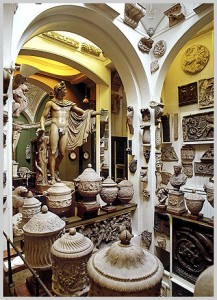Unless you have previous knowledge of the museum beforehand, the John Soane Museum will initially confuse you. Expecting to see another massive and imposing building, the Soane Museum is actually just an inconspicuous house located amidst the London city chaos. Without much of an introduction, I wandered inside holding my purse in a clear plastic bag—the reason for which I learned later on—immediately into Sir John Soane’s past. I wandered through the intricate maze of tall and narrow doorways and winding staircases, coming across only a small number of plaques describing Soane and his belongings. I gradually learned he was an English architect, remembered most for his remarkable skill and his design of the Bank of England.
John Soane’s house was incredible. The detail in the architecture was intricate and the colors and designs were nuanced and distinct. Besides the building itself, the objects it housed seemed for the most part entirely out of place. For example, a large open room, extending from a stone basement to a glass roof, exhibits a myriad of ancient Greek stone architectural pieces. Apparently the room is intended for students to wander through feeling as if in Greece while learning about the architecture. Although I appreciated the museum by the end of my personal tour, I could compare it to another museum I visited in Boston and did not enjoy it nearly as much.
Greek Architecture Exhibit, John Soane Museum
The Isabella Stewart Gardner Museum in Boston, Massachusetts is similar to the John Soane Museum in that it’s a personal home that displays the past owner’s invaluable possessions. Isabella Gardner was not an architect like Soane, but rather a remarkable art collector, patron of the arts, and philanthropist. Unlike the Soane Museum, the Gardner Museum offered a tour as soon as the visitor entered—something vital when there’s an apparent lack of plaques, brochures, and audio guides. Furthermore, the organization and presentation of the pieces in the Gardner Museum was more effective. Instead of a disorganized jumble, Gardner’s rooms centralized the visitors’ focus on one main piece and designed the rest of the art in the room to reflect and elaborate on the piece’s expression. For example, one room displays a striking, passionate sort of painting, while other sculptures, drawings, plants, and the room’s decoration further emulate the painting’s dark, mysterious emotions.
Painting in Isabella Stewart Gardner Museum
In the end, I enjoyed the John Soane Museum as an exploration of one man’s architectural talent and creativity, the rare objects he collected, and his life in 18th and 19th century England. However, it became a challenge when I compared it to another somewhat similar museum that I much preferred over the Soane.



2 responses so far ↓
patrickmr // Sep 16th 2010 at 18:40
You draw an interesting comparison, Mary. I do think that the Soane Museum has a particular charm to it, though, in its cramped randomness. Soane’s house is gorgeous, but it, like the collection it holds, boasts a colorful mixture of styles from an array of time periods. In a way, I think the chaos of the collection almost suits the house. Now if only they’d mark which cabinets guests aren’t allowed to open…
maryc // Sep 16th 2010 at 19:17
Fair enough, Pat. I do agree it was a worthwhile experience in the museum, don’t get me wrong. And the cabinet mishap totally demonstrated English “social dis-ease.” So perfect.
You must log in to post a comment.